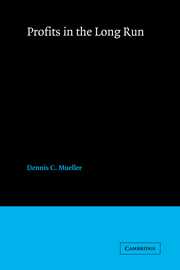Book contents
- Frontmatter
- Contents
- Acknowledgments
- 1 The persistence of firms
- 2 The persistence of profits above the norm
- 3 The persistence of market power
- 4 Profitability and market structure
- 5 The results in perspective
- 6 Profitability and the firm's own advertising, patent activity, risk, and other characteristics
- 7 Profitability and managerial control and compensation
- 8 Mergers and profitability
- 9 Mergers and market share
- 10 The threads gathered and conclusions woven
- Appendix 1 Companies studied
- Appendix 2 Industry categories
- Appendix 3 Industry matchings
- Appendix 4 Assets acquired data (Chapter 7)
- Appendix 5 Mergers and market share: samples of merging companies
- Notes
- References
- Index
4 - Profitability and market structure
Published online by Cambridge University Press: 04 May 2010
- Frontmatter
- Contents
- Acknowledgments
- 1 The persistence of firms
- 2 The persistence of profits above the norm
- 3 The persistence of market power
- 4 Profitability and market structure
- 5 The results in perspective
- 6 Profitability and the firm's own advertising, patent activity, risk, and other characteristics
- 7 Profitability and managerial control and compensation
- 8 Mergers and profitability
- 9 Mergers and market share
- 10 The threads gathered and conclusions woven
- Appendix 1 Companies studied
- Appendix 2 Industry categories
- Appendix 3 Industry matchings
- Appendix 4 Assets acquired data (Chapter 7)
- Appendix 5 Mergers and market share: samples of merging companies
- Notes
- References
- Index
Summary
In this chapter we begin to explore the determinants of persistent profitability. Over the last three decades, a large slice of the industrial organization literature has sought to explain industry or firm profitability on the basis of various industry or company characteristics (see Scherer 1980, Chapter 9; Weiss 1974). Virtually without exception, this literature has been cross-sectional in nature. The implicit assumptions underlying this research have been that the profit differences observed across industries and firms at any point in time are quasi-permanent differences, and that the cross-sectional estimation procedures capture long-run structural relationships. Although the interpretation of cross-sectional regression estimates as measures of long-run slopes and elasticities is rather standard in the literature (see Kuh 1963, pp. 182–6), the permanency of the profits observed in any cross section is open to question. Yale Brozen (1970, 1971a, b) launched his assault on the literature for that reason. The estimates of projected or long-run profitability derived in Chapter 2 should avoid much of the criticism Brozen has raised against previous studies. We use these estimates of projected profitability as the dependent variables in our subsequent work. Our independent variables are drawn from the same sets that other studies have employed, although we place a somewhat different interpretation on some of the variables. The estimating procedures are cross-sectional in nature and we also place a long-run interpretation on the estimated coefficients.
- Type
- Chapter
- Information
- Profits in the Long Run , pp. 50 - 84Publisher: Cambridge University PressPrint publication year: 1986

